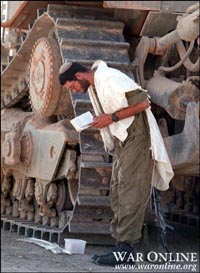israel
Pushing Back
![]() A shareholder resolution to block Caterpillar from selling D-9 bulldozers to Israel picks up momentum.
A shareholder resolution to block Caterpillar from selling D-9 bulldozers to Israel picks up momentum.
Instrumental
Following Brian’s travels through Morocco, I ran into this interesting bit from his visit to Marrakesh that relates to exhibition design:
“Captions [in the Museum of Moroccan Art] were available in both French and Arabic. I originally thought I would be able to understand almost everything from my knowledge of the two languages; however, I quickly discovered a flaw in this plan: The explanations were often different.
For example, in discussing a particular musical style, the French caption talked about how it was derived from Greek forms, while the Arabic explained it as going back to the Abbasid court at Baghdad. Both of these could be true - the people at the Abbasid court could have developed it from Greek forms, but the targeted cultural bias of the information presented is an interested insight into the way the tourist industry operates. I once read an article about how tour guides in Israel change what they highlight and the style of their presentation based on the group they are guiding. The Museum of Moroccan Art in Marrakesh seems to unabashedly post written evidence of this as Arab and European tourists wander through having the information presented in a context which affirms their own culture’s past.”
Brian’s interpretation notwithstanding, he’s on to something: given Morocco’s privileged geography between continents and at the nexus of so many trade routes among regions and empires, I suspect its traditional forms were influenced by very many cultural traditions, long before the histories were spun so neatly into “East” and “West.”
Given that the curators are clearly aware of this, it’s all the more interesting that they choose to present the two distinct narratives rather than a more nuanced account of cultural exchange.
Objects in the Mirror

“A Palestinian threw a rock at an Israeli army bulldozer.”
This photo from Abid Katib/Getty Images appeared on the front page of today’s New York Times online. The image and caption linked to the article Israeli Tanks Enter Gaza; 4 Palestinians Die in Fighting.
In the photo, the Palestinian looms large above the bulldozer. He is a lanky, but determined and formidable force — a dark, faceless enemy poised to smash the small, apparently unarmed machine. The force of his attack is accented by patterns in the clouds, and exaggerated by the tilt of the camera (note the horizon line.) The bulldozer does not seem to be attacking the Palestinian or doing anything other than driving by, going about its business. The article reinforces this, making no mention of the purpose of the bulldozer or why it would need an escort of tanks.
From the photo, you’d have no idea that the bulldozer is 13 feet tall and well protected against his rock.
See the entry on the Caterpillar D9 from wikipedia.org:
“Armored bulldozers are a standard tool of Combat engineering battalions, and the IDF has gained some notoriety for their use of armored tractors in the Al-Aqsa Intifada, Operation Defensive Shield, and their involvement in the demolition of orchards and residences and the consequential death of [U.S. college student] Rachel Corrie....
The operator is protected by bulletproof glass to protect against bombs, machinegun and sniper fire. The fitted armor package adds roughly 10 additional tons to the weight to a so-equipped D9. Like many customized packages, individually modified D9s may be found with disparate features, such as crew-operated machine guns, smoke projectors, or grenade launchers....
The Israeli armor kit proved itself well, as no D9 operator was killed during the 3-year long al-Aqsa Intifada.”
The U.S.-based Caterpillar Corporation manufactures the D9. The Israeli Defence Force developed the armor kit. Last year, Israel’s Technion Institute of Technology, announced a remote controlled version of the D9.
The Israeli Committee Against House Demolitions reports that the IDF has demolished over 10,000 houses in the Occupied Territories since 1967. The Caterpillar D9 was used to demolish an entire neighborhood in the Jenin refugee camp in April 2002.
Other photos show a very different scale:
For more information, see Stop Caterpillar, a campaign to hold the Caterpillar Corporation accountable for the criminal use of its products by the Israeli army.
Your Tax Dollars at Work
SUSTAIN is an acronym for “Stop U.S. Tax-Funded Aid to Israel Now.” They are:
“a group of women and men who have come together in cities across the country by our responsibility and concern as U.S. taxpayers. We understand that our tax-dollars fund Israeli violations of Palestinian national and human righ.”
They publish the 1040WAR Form, a one-page fact-sheet handout that parodies the IRS’s 1040EZ income tax form and provides information about U.S. support for Israel. Download the PDF. Sources for the information on the form are available here.
Olive Branch
 “In Israel, a forest of 6 million trees is being planted in the Judean hills between Jerusalem and Tel Aviv, in the words of B’nai B’rith, ‘as a living memorial to the six million Jews who perished in the Holocaust.’ Begun in 1954, this planting clearly takes on several layers of practical and symbolic meaning in Israel: it remembers both the martyrs of Nazi genocide and a return to life itself as cultivated in the founding of the State. Rather than remembering the victims in the emblems of destruction left behind by the Nazis, thereby succumbing to the Nazi cult of death, these trees recall both the lives lost and the affirmation of life itself as the surest memorial antidote to murder. It was also with this traditional veneration of life in mind, as symbolized in Jewish tradition by the Etz Chaim (tree of life), that Yad Vashem has planted a tree to remember and to name every single Gentile who rescued a Jew during World War II.” [source]
“In Israel, a forest of 6 million trees is being planted in the Judean hills between Jerusalem and Tel Aviv, in the words of B’nai B’rith, ‘as a living memorial to the six million Jews who perished in the Holocaust.’ Begun in 1954, this planting clearly takes on several layers of practical and symbolic meaning in Israel: it remembers both the martyrs of Nazi genocide and a return to life itself as cultivated in the founding of the State. Rather than remembering the victims in the emblems of destruction left behind by the Nazis, thereby succumbing to the Nazi cult of death, these trees recall both the lives lost and the affirmation of life itself as the surest memorial antidote to murder. It was also with this traditional veneration of life in mind, as symbolized in Jewish tradition by the Etz Chaim (tree of life), that Yad Vashem has planted a tree to remember and to name every single Gentile who rescued a Jew during World War II.” [source]
......
“Israel’s Defence Ministry is investigating reports that Palestinian olive trees uprooted to make way for a security fence are being sold illegally to rich Israelis and town councils, sometimes for thousands of pounds each.
The illegal trade in olive trees has flourished as Israeli contractors, supported by armed guards, clear Palestinian agricultural land where an 80-mile electronic fence is being built to seal off the West Bank.
Thousands of olive trees have been dug up to make way for the 150-ft wide barrier and security zone. Its route usually passes inside Palestinian territory, not along the old pre-1967 border, and thousands of Palestinian farmers say their livelihood is being taken away.
Sale of the olive trees emerged after the owner of a contracting company offered two reporters from a popular Israeli newspaper, Yedioth Ahronoth, 100 large olive trees for £150 each.
The reporters found one enormous tree, said to be 600 years old, on sale at an Israeli plant nursery for £3,500. They said the trade was conducted with the complicity of an official in the civil administration, the Israeli military government in the occupied territories....
Olives are the lifeblood of Palestinian agriculture, almost the only crop which grows on the stony hillsides of the West Bank without irrigation. Most Palestinians are unemployed after two years of violence and their staple diet is bread and olive oil.
About 11,000 Palestinian farmers will lose all or some of their land holdings to the fence. Sharif Omar, from the village of Jayous, near the Israeli town of Kochav Yair, said: ‘I have lost almost everything. I have lost 2,700 fruit and olive trees. And 44 of 50 acres I own have been confiscated for the fence.’
His village lost seven wells, 15,000 olive trees and 50,000 citrus and other fruit trees. ‘This area is the agricultural store for the West Bank. They are destroying us,’ he said.” [source]
Techniques of Electronic Advocacy
This entry has been updated and incorporated into An Introduction to Activism on the Internet.
I’ve been searching for a list of excellent examples of Internet activism. I couldn’t find one, so I made my own.
I’ve structured much of this list around categories outlined by Sasha Costanza-Chock in “Mapping the Repertoire of Electronic Contention,” in Representing Resistance: Media, Civil Disobedience and the Global Justice Movement, eds. Andrew Opel and Donnalyn Pompper. Greenwood, in press. Unless otherwise indicated, the quoted text below has been taken from him.
Though I’ve added some of my own commentary, this is not intended to be a full analysis of the campaigns and organizations mentioned. I disagree with the politics of many of the examples listed, but think there is something to be learned from each of the them.
Design Against the War
Over a year ago I attended a lecture on design at the Cooper Union. The speaker projected a series of slides illustrating his minimalist design philosophy. One of the images was of the B-2 bomber. I was shocked and disturbed that a design philosophy would fail to take into account social, political, and economic contexts. Particularly of an object which, when used as intended, delivers massive death and destruction.
It prompted me to dig deeper into design and the public interest. And to start this Web log.
On evening of April 16, I arranged a panel discussion at Cooper titled “Design in the Public Interest / Design Against the War.” I invited three panelists to speak about their work as designers involved in the anti-war movement.
 First up was Lee Gough, a printmaker, anti-war activist, and graphic artist based in Brooklyn, NY. She showed a series of prints from a portfolio-in-progress on the Iraq invasion and the war at home, called “The War Went Well.” Some of the images have been used in posters on the Web site Who Dies for Bush Lies“ and for Military Families Speak Out, an organization of people who are opposed to war in Iraq and who have relatives or loved ones in the military.
First up was Lee Gough, a printmaker, anti-war activist, and graphic artist based in Brooklyn, NY. She showed a series of prints from a portfolio-in-progress on the Iraq invasion and the war at home, called “The War Went Well.” Some of the images have been used in posters on the Web site Who Dies for Bush Lies“ and for Military Families Speak Out, an organization of people who are opposed to war in Iraq and who have relatives or loved ones in the military.
One image “Fight the War at Home” was inspired by a subway ride home from lower manhattan on September 11. Even as the towers had just been destroyed, there were still, as there had been for many years, homeless persons on the subway appealing to cityfolk to remember them, and to give. The image is a graphic reminder that some have been under domestic attack in our country for a long time, and that funds for the war on poverty pale in comparison to our “defense” budget. Another image, “Visualize Your Family Members Waging War” depicts a despondent soldier with a crutch being embraced by a woman. Lee’s expressive linocut style brings a gravity to the subject matter.
Lee commented on the challenges of choosing one’s message, for instance, noting the different context of “Bring the Troops Home” for troops that have been drafted vs. those who enlisted voluntarily.
One member of the audience raised the question of why U.S. flags and “being American” were the province of the pro-war movement, when large numbers of U.S. citizens were opposed to the war. I noted that I’d seen many anti-war demonstrators holding up flags and patriotism at rallies. On the Web, Who Dies for Bush Lies? effectively tackles effect of the war on U.S. soldiers and U.S. civilians, in addition to Iraqi soldiers and civilians. The danger was raised, though, of the rhetorical trap: the argument over who is “more American” can go back and forth forever, and quickly turning attention away from the crisis at hand.
 Nancy Doniger has worked as an illustrator for almost 20 years, producing art work for newspapers, magazines, books, posters and T-shirts for both for-profit clients and not-for-profit groups. She is currently a member of Brooklyn Parents for Peace, for whom she created the “Say No to War Against Iraq” poster.
Nancy Doniger has worked as an illustrator for almost 20 years, producing art work for newspapers, magazines, books, posters and T-shirts for both for-profit clients and not-for-profit groups. She is currently a member of Brooklyn Parents for Peace, for whom she created the “Say No to War Against Iraq” poster.
She also helped organize a community/family oriented workshop that gave kids and parents an opportunity to make anti-war art for protest marches. Adults and kids made signs and worked with a puppeteer to create a large paper mache dove, and lots of little doves held aloft on cardboard tubes.
Nancy showed some earlier examples of her work, including a forceful image against the FTAA, a stark two-color poster for a conference on the conflict in Israel and Palestine, and a bright, celebratory “Welcome Back to Brooklyn” poster.
She also showed a couple of iterations of the “Say No to War” poster. One implied the damage of war with flames, but the final version ultimately centered on the mass mobilization. She noted that, in contrast to other illustrations, her work on this piece progressed from representation to geometric abstraction to make the poster more inclusive, using large blocks of color instead of specific depictions of race and gender. She is currently working on a “Hate Free Zone” poster.
Nancy noted the effect of the “Say No to War” poster on her block. The block appeared to be a very pro-war, where “the flags are quick to come out.” But over time, the “Say No to War” poster began to appear in windows and doorways. I certainly noticed it up and down the block where my step-sister lives.
Nancy is also involved in upcoming anti-war event “WEARNICA.” Sponsored by Brooklyn Parents for Peace, on May 3, 2003 a group of artists will present original anti-war art executed on the backs of white cotton dress shirts. The shirts will be worn in public spaces around New York and the world. The event was conceived by Works on Shirts Project whose inspiration for the event came after Colin Powell insisted upon covering the tapestry of Picasso’s Guernica during his warmongering speech to the General Assembly of the United Nations on February 5, 2003.
L.A. Kauffman is a staff organizer for United for Peace and Justice and designer of materials to promote the February 15 and March 22 marches in New York City. Her sticker and poster designs United for Peace and Justice can been seen on the streets across the New York City.
Leslie arrived at design through her work as editor of a progressive journal. She was inspired by the bold, clear graphics of Gran Fury and ACT-UP, and the use of those graphics on the street and at demonstrations, stage managing the events to push its imagery into the mainstream media. She claims she can not draw, so uses clip art in her graphics. The image of the blue pennant flag and black group have become a ubiquitous the city streets.
The idea behind a worldwide day of anti-war marches came out of the European Social Forum held in Florence this past November. At the Forum, the date February 15 was chosen as a date for anti-war demonstrations “in every capital.” What transpired was unexpected and unprecedented.
United for Peace and Justice had only just formed in the November of 2002, but it wasn’t January the group started working on the February 15 march. 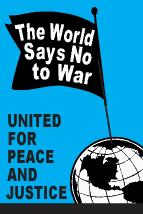 “The World Says No” was the headline of the February 15 flyer design, accompanied by a list of cities taking part in the event. As news of the event travelled across the Internet, marches were planned in more and more cities. Leslie held up various versions of her February 15 design with more and more cities added. Ultimately, marches were held in 793 cities around the world on February 15. Of particular note is virtual absence of communication or coordination between the participating cities.
“The World Says No” was the headline of the February 15 flyer design, accompanied by a list of cities taking part in the event. As news of the event travelled across the Internet, marches were planned in more and more cities. Leslie held up various versions of her February 15 design with more and more cities added. Ultimately, marches were held in 793 cities around the world on February 15. Of particular note is virtual absence of communication or coordination between the participating cities.
Leslie spoke of the focused purpose of the posters produced for the event: not to educated, but to mobilize. The flyers lack all superfluous text or argument, just the headline, time and place. The posters and stickers were not trying to change people’s minds, instead to reach out to people who were already against the war but had not yet taken action.
In addition to sticker and flyers, palm cards cut from 1/4 page xerox copies on blue paper were popular and successful. They are both cheaper and more effective — easier to stuff in your pocket, less burdensome on the counter tops of sympathetic shopkeepers.
For the February 15 march, 200,000 stickers were distributed in 5 weeks. For the March 22 march, 200,000 stickers were distributed in 3 weeks. Astonishing numbers, posted around town by a continual flow of volunteers through the office. It’s also a useful bench mark: this is how many it takes to spread the message. A month later, I’m still finding remnants of UPfJ stickers on walls and phone booths. Leslie noted the effect of thousands of little acts of civil disobedience for the spirit of protestors, slowly bolstering a spirit of resistance around in the City and specifically, against the police department ban on marching past the U.N. on February 15.
In total, 1.1 Million pieces of literature distributed. Almost all of the printed materials were bilingual: English on one side, Spanish on the other. However, materials were also produced in Korean, Spanish, French, Creole, and Chinese. Quite a few donations for all these production expenses came online via paypal.
The question was raised about the environmental impact of producing all those printed materials. Her response: it’s also better for the environment if the war is prevented.
 Other examples of design projects were raised by members of the audience: a “Do Not Bomb Iraq” sticker to replace the “Do Not Lean On Doors” sticker in NYC subway cars; colorful logos, charts and imagery designed by Stefan Sagmeister for “Move Our Money,” a campaign to reallocate 15% of the U.S. military budget for education; and flyers handed out to tourists at ground zero with a graphic representation of the number of teachers aides that will be cut from City’s budget. The image leaves it to the viewer to make to the connection to the military expense of a war in Iraq.
Other examples of design projects were raised by members of the audience: a “Do Not Bomb Iraq” sticker to replace the “Do Not Lean On Doors” sticker in NYC subway cars; colorful logos, charts and imagery designed by Stefan Sagmeister for “Move Our Money,” a campaign to reallocate 15% of the U.S. military budget for education; and flyers handed out to tourists at ground zero with a graphic representation of the number of teachers aides that will be cut from City’s budget. The image leaves it to the viewer to make to the connection to the military expense of a war in Iraq.
Many spoke of the importance of New Yorkers being seen as against the war. September 11 was an attack on New York, and the war is being waged in our name. Others spoke of the urgency of independent media, and the challenge of reaching out beyond “preaching to the converted.”
Overall, I was struck by how spontaneous the designers’ actions were. In almost every case, the designers simply stepped forward and got involved: signs made for a rally were eagerly snapped up; hundreds of thousands of stickers eagerly taken and distributed; and, “Say No to War” posters popped up on an otherwise apparently pro-war street. It seems that one doesn’t necessarily have to change everyone’s minds. There are more “converted” than you think. They just don’t have the graphic materials to display yet.
About 50 people came to the event, a decent turnout despite the announcement from the Pentagon the previous day that “the major fighting” in Iraq was over... and the fact that I’d scheduled the event on the first night of Passover. (Such a Jew am I.) The arc of the event could have used a better closing at the end, as well as a better transition between panelists. I also noted the lack of diversity in the audience. I think next time, I should hold it at different time and place. I’m also quite pleased with the invite design. Peel off the event description and you’re left with an anti-war sticker. Many thanks to Photobition for helping hammer this out in time.
One purpose of the event was to connect artists, designers, and activists. I’m disappointed more Cooper students didn’t show, but after the event quite a few people milled around having these intense little conversations until I kicked everyone out to close the room and return the lights. And quite a few people asked me what was next. Perhaps the start of a new Committee to Unsell the War?
Under the Asphalt, the Cobblestones
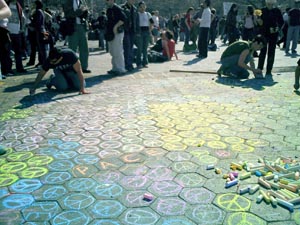
Protestors after the march in New York City yesterday chalked messages around Washington Square Park.
As the U.S. invades Iraq and activists around the world take to the streets, here in New York I’m noticing how the city itself is increasingly used as a medium by the anti-war movement.
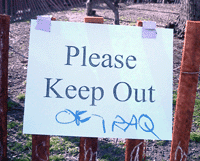 Much of this is nothing new. City streets have always been checkered with posters, graffiti, flyers, and stickers. Subway ads are often annotated with running commentary, sometimes sexual but just as often critical of the ad and advertiser itself (or just blacked out teeth on a too-cheerful model.)
Much of this is nothing new. City streets have always been checkered with posters, graffiti, flyers, and stickers. Subway ads are often annotated with running commentary, sometimes sexual but just as often critical of the ad and advertiser itself (or just blacked out teeth on a too-cheerful model.)
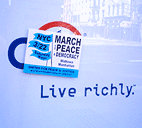 The anti-war movement has taken advantage of all of this. United for Peace and Justice stickers seem to be everywhere — on pay phones, mailboxes, street lamps, walls, and signage. The letters “STOP BUS” on the street are altered to read “STOP BUSH.” In the Baghdad Snapshot Action activists have simply postered ordinary snapshots from Iraq: “Quiet and casual, the snapshots show a part of Baghdad we rarely see: the part with people in it.”
The anti-war movement has taken advantage of all of this. United for Peace and Justice stickers seem to be everywhere — on pay phones, mailboxes, street lamps, walls, and signage. The letters “STOP BUS” on the street are altered to read “STOP BUSH.” In the Baghdad Snapshot Action activists have simply postered ordinary snapshots from Iraq: “Quiet and casual, the snapshots show a part of Baghdad we rarely see: the part with people in it.”
And then there was the march of over 200,000 people down midtown Manhattan yesterday.
But as the war escalates, so do the protests. And so does the reconfiguring of public space. Activists in San Francisco last week shut down traffic throughout the city with autonomous direct actions coordinated online. Activists hauled newspaper kiosks, cafe chairs and tables, and other street furniture into the streets. [article and photos]
What will be the government’s response? Some communities are all too familiar with locked down, fenced in, and video monitored public spaces. Once considered an invasion of privacy, cameras and other measures are increasingly justified as a legitimate response to terrorism. In the name of anti-terrorism, the City recently sought and won a loosening of the law that restricted on police surveillance of political groups. The restrictions were imposed by the settlement of a 1971 lawsuit over harassment of political advocacy groups by the Police Department’s so-called “Red Squad.”
Public amenities and the details of public life are being reshaped elsewhere in the fight against terrorism. In Israel, seating at bus stops is often bolted to the wall (no chair legs to hide things behind), every turnstile will soon have a metal detector installed, and every trash can on the street will be replaced with see-through plastic and wire receptacle. In Washington, D.C., subway trash cans are being replaced with bomb-resistant models. In the Tokyo subway, there are no trash cans at all anymore.
Not to mention Israel’s wall.
This week New York City announced Operation Atlas, additional security measures to try to protect us against terrorist attack during wartime. I’m not opposed to greater inspection of cargo entering the City, but have no doubt that the NYPD will use their new powers to target activists and political dissent. I also note that the plan, which costs $5 million a week comes at a time of severe budget cuts in NYC — and a deficit of nearly $4 billion. Was factored into the costs of the war?
Literature on cities is replete with the metaphor of public space as the site and the physical embodiment of democracy. In the weeks and months ahead, I wonder how our public space will change.
See NYC IndyMedia and Gotham Gazette’s page on New York City and the War.
Infrastructural Warfare
“The Israel—Palestine war is not simply a struggle over territory between two national entities. It is driven by Israel’s systematic denial of modern urban life to the Palestinians. One of the lessons of the battle of Jenin is that the bulldozer that demolishes houses is also a weapon in the wider strategy to prevent the Palestinians from creating a modern, normal, urban society.”
See ‘Clean territory’: urbicide in the West Bank by Stephen Graham on OpenDemocracy.
Israel's Wall
Construction has begun on a “security barrier to separate Israel from the West Bank.” BBC: “As always, it boils down to a question of land: Israel taking Palestinian land to ensure its security.... In the absence of a peace settlement, the fence has raised all the old questions about where Israel ends and the West Bank begins.” Some villages will be split in half, or annexed entirely. VOANews: Yasser Arafat “described the $220 million fence as a ‘sinful assault on our land, an act of racism and apartheid, which we totally reject.’” News24: “Veterans from both sides of the Berlin Wall say Israel’s... plan to erect 110km of fence along the West Bank will fail ultimately, much as the Cold-War divide through Berlin eventually crumbled.”
Update March 23, 2003: While the first wall proceeds apace, Israel is planning a second wall.


